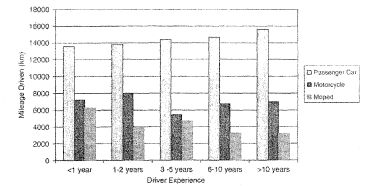
This paper investigates the mobility patterns of powered two-wheeler riders in comparison to those of passenger car drivers in Greece, a country where an increased two-wheeler ownership and related traffic is observed. A nationwide travel survey targeted at two-wheeler and passenger car active drivers was carried out on that purpose. The results of the survey were exploited in two ways; first, the usage of the examined vehicle types in Greece was investigated in relation to driver characteristics, through the calculation of the respective sample distributions. The results demonstrated a clear difference between vehicle ownership rates and vehicle usage rates per vehicle type. Moreover, the mobility patterns of each vehicle type were comparatively analyzed, on the basis of the average yearly mileage travelled, in relation to driver (age, gender, experience), vehicle (engine size) and type of trip (weekday/ weekend) and road environment (area type, lighting conditions, road type), providing interesting results. In particular, driver gender, age and experience appear to be a stronger determinant of mobility patterns than vehicle type. On the other hand, different mobility patterns amongst vehicle types in different road environments were identified, suggesting that mopeds and motorcycles are preferred for particular types of trips (e.g. travelling in residential areas and weekdays during daytime) whereas passenger cars may be used in all cases.
| ID | pj32 |
| Manuscript | |
| DOI | |
| Tags | driver behaviour, motorcyclists, traffic management |







